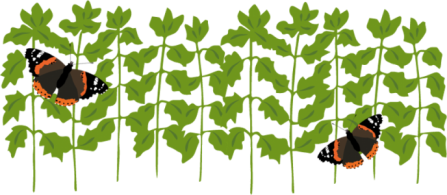Provide food for caterpillars and choose nectar-rich plants for butterflies and you’ll have a colourful, fluttering display in your garden for many months.

While just about any flower with nectar can be a boon for butterflies (cottage garden plants in particular), it is a slightly different story for caterpillar food plants (known as host plants). In fact, most butterfly species have just a short list of host plants. This is possibly because eating leaves and stems is a trickier business, with plants evolving chemical and physical defences against this kind of munching. It may also be that caterpillars need particular chemicals from that plant to bring out their warning colouration as butterflies.
Just about any flower with nectar could be a boon for butterflies
Growing host plants for caterpillars in the garden is not necessarily guaranteed to attract the relevant butterflies, but butterflies do breed in gardens, so it is worth experimenting with different host plants to see which species might find your garden suitable.
It is also worth remembering that some butterflies and caterpillars overwinter, so shelter in the garden, such as thick growths of ivy, is also important.

Plants for butterflies
Species |
Host plant |
|
Common Bird’s-foot-trefoil (Lotus corniculatus) |
|
|
Common Bird’s-foot-trefoil (Lotus corniculatus), Horseshoe Vetch (Hippocrepis comosa) |
|
|
Hedge Mustard (Sisymbrium officinale), Cuckooflower(Cardamine pratensis), Nasturtium (Tropaeolum majus) |
|
|
Holly (Ilex aquifolium), Ivy (Hedera helix) |
|
|
Cultivated varieties of Brassica oleracea, such as Cabbage and Brussel-sprouts, Nasturtium (Tropaeolum majus), Wild Mignonette (Reseda lutea) |
|
|
Grasses: fescues (Festuca spp.), meadow-grasses (Poaspp.), bents (Agrostis spp.) |
|
|
Cuckooflower (Cardamine pratensis), Garlic Mustard(Alliaria petiolate), Honesty (Lunaria annua) |
|
|
Thistles (Cirsium spp. and Carduus spp.), Stinging Nettle(Urtica dioica), |
|
|
Stinging Nettle (Urtica dioica) |
|
|
Stinging Nettle (Urtica dioica), Hop (Humulus lupulus) |
|
|
Cock's-foot (Dactylus glomerate), False Brome (Brachypodium sylvaticum), Tufted Hair-grass (Deschampsia cespitosa), Common Couch (Elytrigia repens) |
|
|
Common Sorrel (Rumex acetosa), Sheep's Sorrel (Rumex acetosella) |
|
|
Stinging Nettle (Urtica dioica), Small Nettle (Urtica Urens) |
|
|
Cultivated varieties of Brassica oleracea, such as Cabbage, Nasturtium (Tropaeolum majus), Wild Mignonette (Reseda lutea), Hedge Mustard (Sisymbrium officinale), Garlic Mustard (Alliaria petiolate) |

